8 Lessons From Chopin’s Prelude Op. 28 No. 20
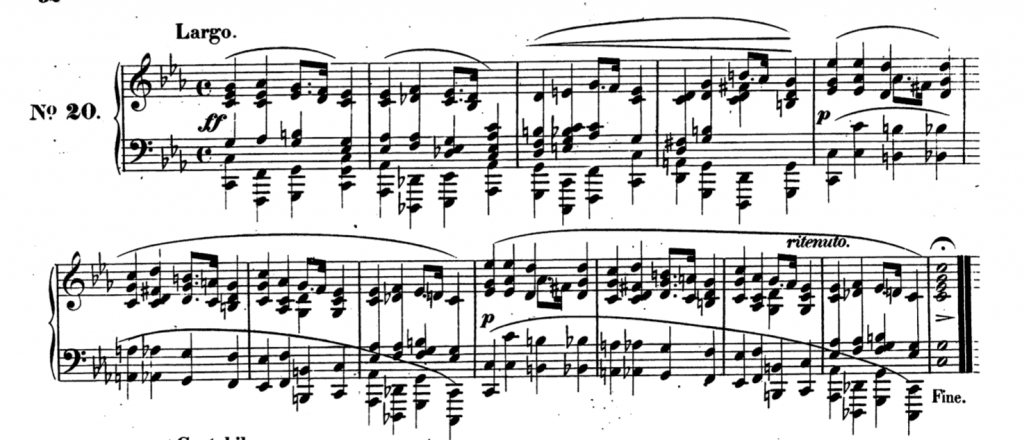
There are a tonne of lessons we can learn as composers from this, it’s relevant for guitar players and classical pianists alike
First, give the piece a listen. It’s barely 2 minutes long:
https://www.youtube.com/EsKwtXgFo24
How does this piece work?
The first bar gives us the main theme for the prelude, and each following bar gives us variations on that theme. It’s quite beautiful. Chopin shows us different uses of a few different music theory concepts for:
- Using V7add6 chords
- Picardy thirds
- Using the Neapolitan chord
- Implementing chords from minor keys
- Secondary dominants
- How to create a chromatically descending bass line with non-diatonic chords
- Different applications of cadences
- Modulating to different keys
- I’m putting this in a separate article… because it is going to take a lot of writing by itself!
All of these examples are ways that we can “dip” out of key, without sounding discordant (like we made a mistake). The fancy term for dipping out of key is using ‘non-diatonic’ chords.
So here we go, 8 ways Chopin demonstrates how to use non-diatonic chords, to make our chord progressions sound more interesting and some other stuff:
How to make dominant chords more interesting
Add a 6th. So that we get:
V7add6
After playing V7add6, we follow it with a standard V7 chord.
Here is one way to implement this on a guitar with barre chords:
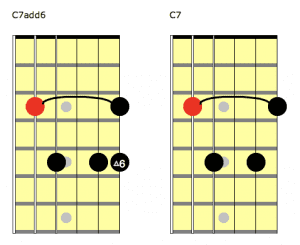
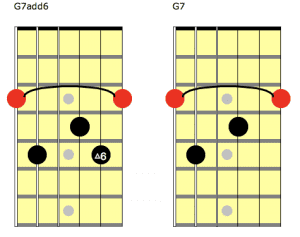
Here are two places in the score where Chopin uses this idea:
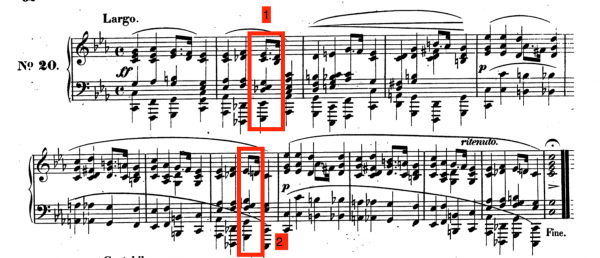
Example 1 is: Eb7add6 Eb7
Example 2 is: G7add6 G7
Structure
Chopin uses an ABB structure for this:
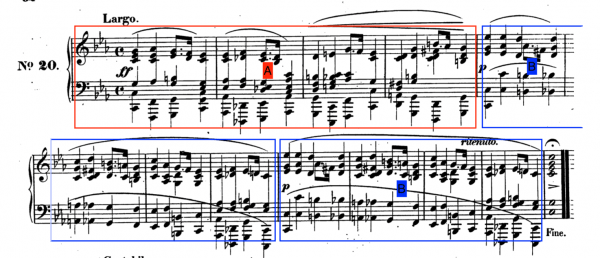
How to use a Picardy 3rd
A Picardy 3rd is when we are playing in a minor key, and we end on a major chord with the root of the key. For example, playing in C minor and ending the piece on a C major chord. It gives a more “hopeful” feeling to the end of the piece. Chopin throws one of these in at the end of bar 3:
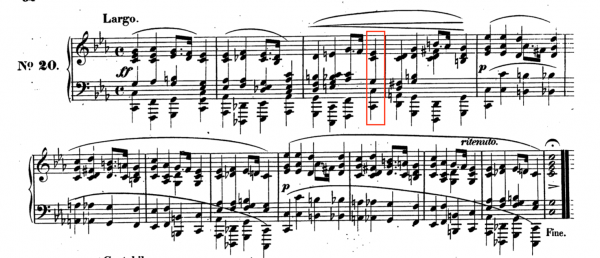
Using the Neapolitan chord
Often abbreviated to ‘N’, the Neapolitan chord is pretty nice in a minor key, because it gets rid of that awkward iio chord (the diminished chord on the 2nd of the scale). Another example of this is in Yngwie Malmsteen’s ‘Liar’ in the arpeggio sequence. Anyway, here are a few places Chopin uses it:
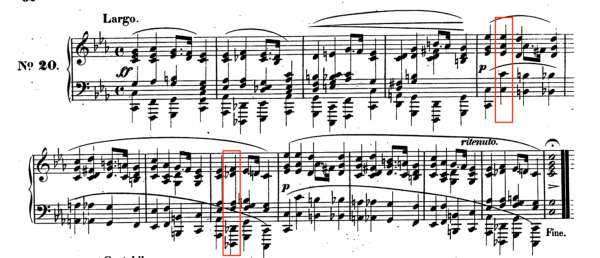
Note that where marked, the bars are in different keys. So our N for the key of C minor is Db major. In the first marked N chord, the bar is in the key of G minor, so the N chord is Ab major. In the second N chord that is marked, the key is C minor (same as the first bar), so our N chord is Db major.
The Neapolitan chord can be used as a regular chord from the key, it doesn’t need to be in a particular inversion.
Implementing chords from minor keys
When playing in a minor key, we don’t need to limit ourselves to chords just from that specific minor key we are in. For example, if we are using the key of C natural minor (or C Aeolian), we can also use chords from C harmonic minor and C natural minor interchangeably.
The piece starts off in C natural minor with the chords:
i iio bIII iv v bVI bVII
C- Do Eb∆ F- G- Ab∆ Bb∆
But, in the piece, we also get the chord G∆ being used. G∆ is a V, instead of v which is G- in the key of C natural minor. The G∆ is the V chords from the harmonic minor key.
Swapping out the v in a minor key for the V is great for making a more dramatic resolution!
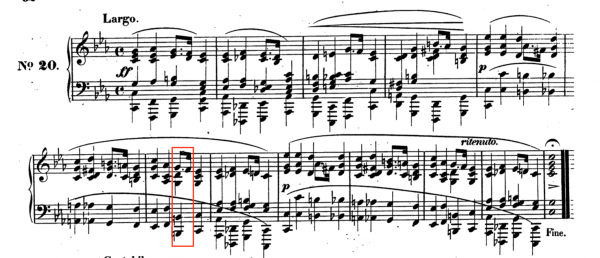
Secondary Dominants
These are a neat way to spice up a chord sequence and throw a bit of suspense into an otherwise bland set of chords (which is to say that Chopin is using a bland set of chords).
You can read about secondary dominants on Wikipedia here
Here is where Chopin uses them in this prelude:
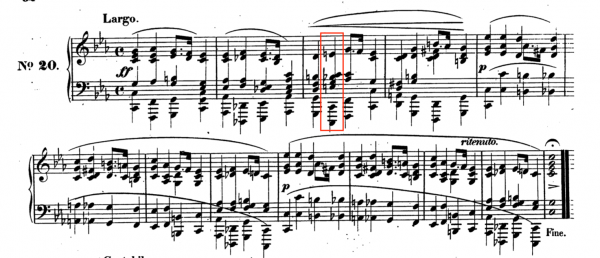
A good hint for a chord being a secondary dominant is when you see a 7th chord that is not in the key. Check if it’s the V7 for the following chord – its probably a secondary dominant. In this third bar, we have:
G7 C7 Fmadd9 Fm C∆
Where the C7 is acting as a secondary dominant for F-add9.
Chromatically Descending Bass Lines with Non-Diatonic Chords
Bars 5 and 6 both have chromatically descending bass lines:
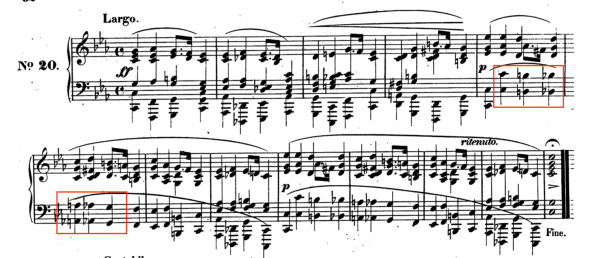
Chopin achieves the chromatically descending bass line in a different way each time:
Bar 5
Here, he is in the key of G minor with the following chords:
iv N biiø i
C- Ab∆ Abø/B G-
The chromatic descent starts with the N chord, moves to the bviio chord, and then ends on the i chord, with a iii thrown in for a bit of spice (a borrowed chord) just before the I chord. So Chopin is using two non-diatonic chords here, the N and the iii. The iii also helps setup the resolution to the i, creating contrary motion in the resolution.
Bar 6
Chopin uses a V7b5 (an altered dominant chord) to create the descending bass line.
Here’s one way to play with chords on your guitar preserving the bass line movement:
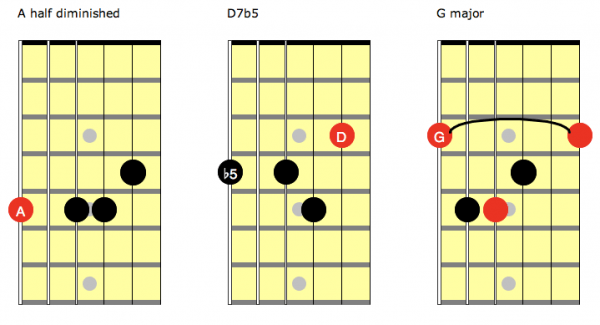
It sounds pretty cool. It’s a crazy dramatic way to resolve to a major chord!
Pretty neat. So there are two practical ways to use a Neapolitan and altered dom7 chord.
These little descending bass lines sound great when you have clean guitars doing some atmospheric chord playing. If you want an example of this, listen to the clean section in the middle of my song “”. You can clearly hear a descending bass line in the chords that I’m playing.
Different Applications of Cadences
Chopin uses a few difference cadences in this piece. A cadence is a way of ending a piece of music. Here is an explanation of the cadences that Chopin uses:
Perfect cadence: V – I
Imperfect cadence: V – I where there are inversions
Plagal cadence: IV – I
Picardy cadence: Ending on the major chord of the tonic at the end of a musical section that is either in a modal or minor key.
You can read more on cadences here
Here are some different ways Chopin applies cadences in each bar:
- Perfect cadence
- Perfect cadence
- Plagal cadence
- Perfect cadence
- Leading tone imperfect cadence (viio -> I)
- Half cadence (I’ll explain this in Part 2)
- Perfect cadence
- Perfect cadence
How can you get the most out of this?
Take each section, one at a time, and listen to the Chopin piece. Specifically, listen for how the technique Chopin uses, sounds. How does it make you feel? How would you describe it? If you had to describe a painting that described that emotional quality, what would it look like?
Learning how to associate theory techniques with emotions is vital to becoming a better composer
Then, take your guitar, and play around with the ideas. Write some music!